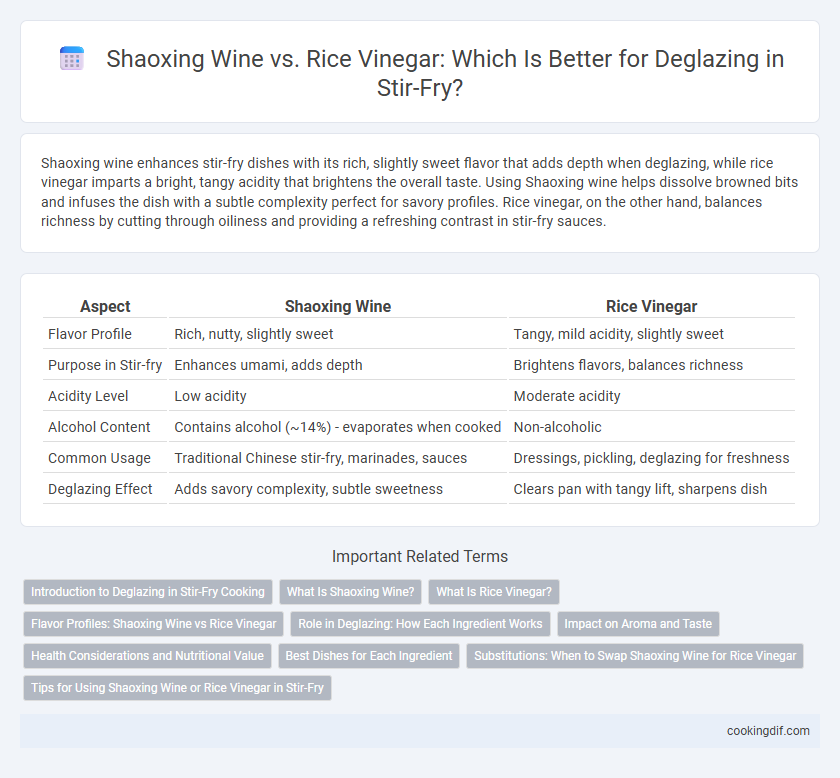Shaoxing wine enhances stir-fry dishes with its rich, slightly sweet flavor that adds depth when deglazing, while rice vinegar imparts a bright, tangy acidity that brightens the overall taste. Using Shaoxing wine helps dissolve browned bits and infuses the dish with a subtle complexity perfect for savory profiles. Rice vinegar, on the other hand, balances richness by cutting through oiliness and providing a refreshing contrast in stir-fry sauces.
Table of Comparison
| Aspect | Shaoxing Wine | Rice Vinegar |
|---|---|---|
| Flavor Profile | Rich, nutty, slightly sweet | Tangy, mild acidity, slightly sweet |
| Purpose in Stir-fry | Enhances umami, adds depth | Brightens flavors, balances richness |
| Acidity Level | Low acidity | Moderate acidity |
| Alcohol Content | Contains alcohol (~14%) - evaporates when cooked | Non-alcoholic |
| Common Usage | Traditional Chinese stir-fry, marinades, sauces | Dressings, pickling, deglazing for freshness |
| Deglazing Effect | Adds savory complexity, subtle sweetness | Clears pan with tangy lift, sharpens dish |
Introduction to Deglazing in Stir-Fry Cooking
Shaoxing wine enhances stir-fry dishes with its rich, aromatic flavor, perfect for deglazing by lifting browned bits from the pan to deepen the sauce complexity. Rice vinegar offers a sharp, tangy acidity that brightens flavors during deglazing, balancing richer ingredients with subtle sour notes. Choosing between Shaoxing wine and rice vinegar depends on desired taste profiles, whether aiming for savory depth or refreshing acidity in stir-fry cooking.
What Is Shaoxing Wine?
Shaoxing wine is a traditional Chinese rice wine made from fermented glutinous rice, known for its rich, slightly sweet, and nutty flavor profile. It is commonly used in stir-fry recipes to deglaze the pan, adding depth and complexity to the sauce while enhancing the dish's umami taste. Unlike rice vinegar, which provides acidity and tang, Shaoxing wine offers a subtle sweetness and aromatic character that balances savory ingredients during cooking.
What Is Rice Vinegar?
Rice vinegar, a mild and slightly sweet vinegar made from fermented rice, is commonly used in stir-fry dishes to add acidity and enhance flavors during deglazing. Unlike Shaoxing wine, which contributes a rich, savory depth and subtle complexity due to its fermentation and aging process, rice vinegar provides a tangy brightness that balances rich sauces and helps lift caramelized bits from the pan. Its lower alcohol content and sharper taste make rice vinegar ideal for quick-flavor adjustments, especially in vegetarian or lighter stir-fry recipes.
Flavor Profiles: Shaoxing Wine vs Rice Vinegar
Shaoxing wine offers a rich, slightly sweet and nutty flavor that enhances the savory depth of stir-fry dishes, adding complexity and subtle umami notes. Rice vinegar brings a bright, tangy acidity that lifts and balances the flavors, creating a crisp and refreshing finish. Choosing between Shaoxing wine and rice vinegar depends on whether you want to emphasize warmth and richness or sharp, vibrant acidity in your stir-fry.
Role in Deglazing: How Each Ingredient Works
Shaoxing wine enhances deglazing by adding rich, aromatic flavors and slightly sweet notes that complement stir-fry dishes, while its alcohol content helps dissolve browned bits on the pan for a deeper taste. Rice vinegar, on the other hand, provides a sharp, tangy acidity that brightens the dish and balances savory elements during deglazing, effectively lifting caramelized residues without overwhelming the flavor profile. Both ingredients play crucial roles in deglazing but differ in their contribution to taste and aroma, with Shaoxing wine leaning toward warmth and complexity and rice vinegar toward freshness and acidity.
Impact on Aroma and Taste
Shaoxing wine enhances stir-fry by imparting a rich, nutty aroma and a slightly sweet, complex flavor that deepens the dish's overall taste profile. Rice vinegar introduces a sharp, tangy acidity that brightens flavors and adds a crisp, clean finish to the stir-fry. Using Shaoxing wine for deglazing creates a smoother, more aromatic base, while rice vinegar offers a zesty contrast that highlights freshness and balances richness.
Health Considerations and Nutritional Value
Shaoxing wine adds a rich, slightly sweet flavor to stir-fry while containing moderate alcohol content that mostly cooks off, posing minimal health risks. Rice vinegar offers a tangy acidity with low calories and no alcohol, making it a heart-healthy choice rich in antioxidants and acetic acid, which may aid digestion. Both ingredients provide distinct nutritional benefits, but rice vinegar is preferable for those avoiding alcohol or seeking lower calorie options.
Best Dishes for Each Ingredient
Shaoxing wine excels in enhancing stir-fry dishes with rich, savory flavors, making it ideal for recipes featuring chicken, pork, and seafood, where its nutty and slightly sweet profile complements the meats. Rice vinegar, with its bright acidity and mild tang, best suits vegetable stir-fries and dishes highlighting tofu or greens, as it adds freshness and balances richness without overpowering delicate ingredients. Choosing Shaoxing wine or rice vinegar for deglazing depends on the desired flavor depth and the primary components of the stir-fry.
Substitutions: When to Swap Shaoxing Wine for Rice Vinegar
Shaoxing wine offers a rich, slightly sweet umami flavor essential for authentic stir-fry deglazing, enhancing depth and complexity. Rice vinegar serves as a suitable substitute when a tangier acidity is preferred or when avoiding alcohol, adding crisp brightness but lacking Shaoxing's subtle sweetness and fermented notes. Use rice vinegar sparingly and balance with a pinch of sugar to mimic Shaoxing wine's flavor profile while maintaining the stir-fry's overall harmony.
Tips for Using Shaoxing Wine or Rice Vinegar in Stir-Fry
When deglazing a stir-fry, Shaoxing wine adds a rich, slightly sweet depth with its complex umami notes, enhancing meat and vegetable flavors without overpowering the dish. Rice vinegar, with its bright acidity, balances rich ingredients by cutting through oils and adding a tangy zest, ideal for lighter or vegetable-focused stir-fries. For optimal results, use Shaoxing wine in moderate amounts early during cooking to allow alcohol to evaporate, while rice vinegar is best added towards the end to preserve its sharpness and freshness.
Shaoxing wine vs rice vinegar for deglazing Infographic

 cookingdif.com
cookingdif.com